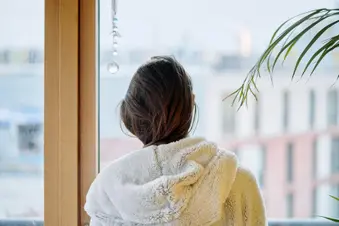
By Alisha Archibald, as told to Kendall Morgan
I first realized that I had vitiligo in 2014. I was getting ready for work -- about to rush out the door -- and, while combing my hair, I saw a small white spot at my hairline. It was on my forehead, about the size of a dime. I thought, “I don’t think I burned myself with the curling iron.” I brushed at it, and it didn’t go away. Immediately, I knew what it was because my grandmother had vitiligo. She’s been gone for 10 years, but my thoughts went right to her.
At first, I didn’t do anything about it. I was afraid to tackle it. I was in denial, perhaps, and thought maybe it would just stay as that one spot. But within a couple of months, I started to notice other spots. I began inspecting my body all over. I thought about my grandmother and how she had hidden herself. Back then, people didn’t know what vitiligo was. They would stare. They hadn’t seen models with vitiligo before like we have now.
It took me a couple of years before I finally went to the doctor. By that time, the spots had spread. I was wearing more makeup to try and cover them. Some of my relatives started asking why I hadn’t gone to the doctor. They’d heard about ways that maybe it could be reversed or slowed. The vitiligo was spreading over my face. I decided it was worth a try to see a doctor and find out what might be done.
The doctor was helpful. She explained that there wasn’t a cure, but there were treatments that might slow it down. There had been cases where people got some pigment back. I listened and decided to try it. She gave me two topical creams and I also got once-a-month injections, including a steroid. Within a month, I thought that I started to see where my skin had a little color coming back. I later learned that it wasn’t a good idea to stay on steroids long term; there can be side effects, so I stopped after about 5 months.
Going to the doctor helped me take control. It helped at a time when I felt like I needed more confidence. The doctor empowered me with more knowledge. I’ve accepted my vitiligo now. I’m not on treatment now, but I know that I have that option. Medicine is a science, and there are new treatments for vitiligo on the horizon.
Self-acceptance is ultimately what’s so important. You need to keep yourself encouraged. There will be days when you don’t feel like you have confidence. At those times, it’s good to rely on those around you who can encourage you when you can’t encourage yourself.
It helps me to be around others with vitiligo. I started a group called So Rare They Stare here in Athens, GA. I created this group to educate others on vitiligo and to encourage others who have vitiligo. It helps to surround yourself with like-minded people. I’ve always been a positive person. When I’m around negative people, I try to turn it around and focus on the positive.
I started seeing the impact of the group I started within the first few months. For example, an older lady in the group had worn makeup to hide her vitiligo for over 30 years. She told me that she cried because she went out for the first time wearing shorts and without makeup on her face. If I can help one person to be OK with themselves, it means so much.
In my community, people know me. I sometimes forget that I have vitiligo. I want to continue to do more to educate and encourage people so that we’ll see more people with vitiligo.
When I was a child, my grandmother didn’t want to go out of the house. We know that vitiligo doesn’t harm our bodies, but it can do harm psychologically. My hope is that people will find whatever works for them -- whether that’s a support group or medication -- to help them step outside the front door. That’s what’s most important.
Show Sources
Photo Credit: Roy JAMES Shakespeare / Getty Images
SOURCE:
Alisha Archibald, Athens, GA.